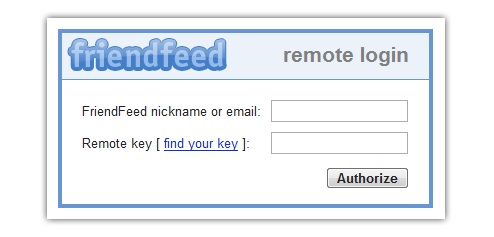
FriendFeed is a fast-growing startup that lets you and your friends share information about what you’re all up to on the web, and talk about it.
We’ve already noticed a lot more people joining the site in the last couple of weeks, and today the pace of adoption is likely to increase even more.
The Mountain View, Calif. company has launched an application programming interface (API) so third-party developers can build their own sites and applications that make use of the data collected, distributed and created through it. Read the company’s blog post here.
Questioning the usefulness of such a service, some users wonder if FriendFeed will not just become another temporary destination site to hold them over until the next one came along. With this API, FriendFeed is clearly aiming for a much larger goal. It makes the service a lot less focused on the actual site and more focused on the data being pulled into the site.
Friendfeed is hoping that people will take its aggregated information about its users’ friend relationships, subscriptions, comments and other data, and use it on other mobile and web applications. One example might be an application that makes it easier to post new photos directly to your feed (as noted below).
This is the latest web site to grow by making communication easier, then letting third parties use the service for their own ends. The most obvious preceding example is Twitter, a simple messaging service that many other sites have incorporated. Even in Friendfeed’s case, it displays Twitter messages and as of yesterday lets you reply directly back to Twitter (our coverage).
One large difference between two services is just how quickly FriendFeed listens to user requests and implements changes. As Mathew Ingram noted yesterday, FriendFeed took only a matter of days to integrate with Twitter, as users were requesting. This stands in contrast to Twitter, which has remained largely unchanged for the past year — many people have even started using FriendFeed to search old Twitter messages because FriendFeed offers that option while Twitter still does not (our coverage).

[Above: The FriendFeed remote login screen for the API]
FriendFeed co-founder Bret Taylor had the following to say about the API release via e-mail today:
I expect we will see a number of desktop applications that make the site more “real time”: alerts for new comments posted to the discussions in which you are participating, alerts for new entries, etc. This type of functionality is certainly one of the most requested features of the site.
I also expect we will see a number of mobile apps that make publishing to FriendFeed easier. You can upload images with the entries posted via the API, which would make it easy to, e.g., make an iPhone app that let you post your iPhone photos directly to FriendFeed with a click of the button.
We put a lot of effort into exposing almost all of the functionality of the web site via the API so developers could develop truly comprehensive read/write applications with the API.
You can find extensive documentation on the FriendFeed API here as well as a helpful FAQ here.
[MG Siegler contributed to this story.]
VentureBeat's mission is to be a digital town square for technical decision-makers to gain knowledge about transformative enterprise technology and transact. Learn More
